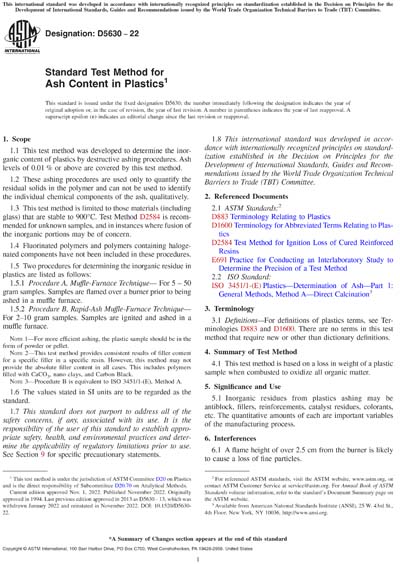Most recent
ASTM D5630-22
Standard Test Method for Ash Content in Plastics
1.1This test method was developed to determine the inorganic content of plastics by destructive ashing procedures. Ash levels of 0.01 % or above are covered by this test method.
1.2These ashing procedures are used only to quantify the residual solids in the polymer and can not be used to identify the individual chemical components of the ash, qualitatively.
1.3This test method is limited to those materials (including glass) that are stable to 900°C. Test Method D2584 is recommended for unknown samples, and in instances where fusion of the inorganic portions may be of concern.
1.4Fluorinated polymers and polymers containing halogenated components have not been included in these procedures.
1.5Two procedures for determining the inorganic residue in plastics are listed as follows:
1.5.1Procedure A, Muffle-Furnace Technique - For 5 "“ 50 gram samples. Samples are flamed over a burner prior to being ashed in a muffle furnace.
1.5.2Procedure B, Rapid-Ash Muffle-Furnace Technique - For 2"“10 gram samples. Samples are ignited and ashed in a muffle furnace.
Note 1:For more efficient ashing, the plastic sample should be in the form of powder or pellet.
Note 2:This test method provides consistent results of filler content for a specific filler in a specific resin. However, this method may not provide the absolute filler content in all cases. This includes polymers filled with CaCO3, nano clays, and Carbon Black.
Note 3:Procedure B is equivalent to ISO 3451/1-(E), Method A.
1.6The values stated in SI units are to be regarded as the standard.
1.7This standard does not purport to address all of the safety concerns, if any, associated with its use. It is the responsibility of the user of this standard to establish appropriate safety, health, and environmental practices and determine the applicability of regulatory limitations prior to use. See Section 9 for specific precautionary statements.
1.8This international standard was developed in accordance with internationally recognized principles on standardization established in the Decision on Principles for the Development of International Standards, Guides and Recommendations issued by the World Trade Organization Technical Barriers to Trade (TBT) Committee.
ASTM International [astm]

